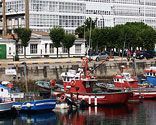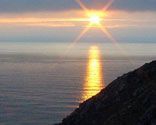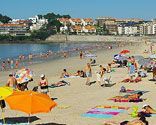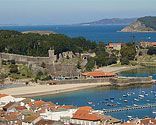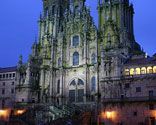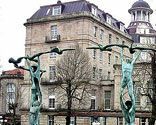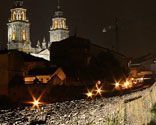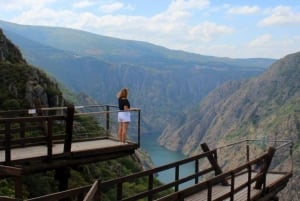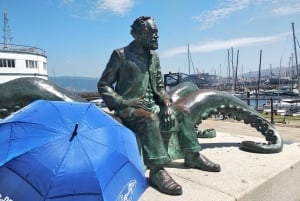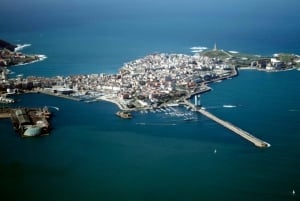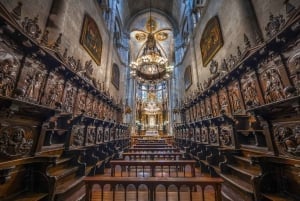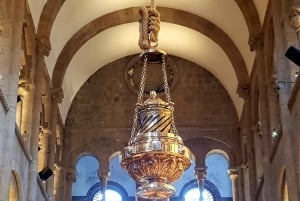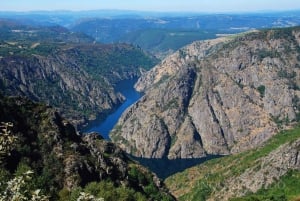Galicia Attractions
Santiago de Compostela
Santiago Cathedral, its square and the labyrinth of harmonious and often moss covered granite streets and buildings around it having originated over a thousand years ago is one of the most beautiful old cities in Spain. The medieval core is a UNESCO World Heritage Site and most of which is pedestrianised can easily be enjoyed on foot.
It is in Santiago Cathedral which still dominates the whole city's impressive setting with its majestic presence where the shrine of St. James (Santiago) the Apostle lies in a crypt under the High Altar. The festival of St. James is on 25 July to celebrate the saint and his shrine. The last holy year was in 2010 (when the festival happens to be on a Sunday) and the celebrations ....
Read more about Santiago de Compostela
Islas Cíes
The Islas Cíes (Illas Cíes) actually comprises of three islands two of which are linked together by a narrow stretch of sandy beach and stand at the entrance to the ría of Vigo and they can be seen rising, impressively out of the sea from far and wide. The separate island is a bird sanctuary which isn't open to the public. The Guardian Newspaper recently voted the Islas Cíes as the best beach in the world! It's a place to rest on a largely deserted beach as numbers on the island are strictly controlled. Alternatively there are some amazing walks and the side that faces the Atlantic is particularly ....
La Coruña
With a population of nearly 245,000 La Coruña is the main financial and business centre in Galicia, stunningly located on a small peninsular surrounded by the sea on all sides. It is a major port city and in summer cruise liners frequently stop on route to the Mediterranean which makes for an impressive sight. Although a lot of the buildings are relatively modern in appearance the old town is well preserved focused around the Town Hall and main square. Renowned for being a fashion centre thanks to being home to world famous brands such as Zara, Massimo Dutti and Caramelo, it's a place to go shopping in its maze of tightly knitted streets centred on Calle Real which adds to the experience. There is a large beach in the centre which is vibrant in the summer. La Coruña is a very welcoming place with some of the best restaurants in Spain and superb nightlife where the visitor is openly welcomed and guaranteed to have a great meal and good time....
Sanxenxo and places nearby
Sanxenxo is often called the Marbella of the north! It is certainly one of the best and most up market resorts in all of Galicia and is normally completely full in July and August when many people arrive especially from the rest of Spain to take their holidays. Like other sheltered resorts with commanding views looking across the Ría de Pontevedra and toward the Illa de Ons it is has a micro-climate all of its own with warm, sheltered waters for bathing and an array of excellent beaches. Real estate values here are arguably the highest in world! With over 60 hotels in the Sanxnexo area it is a very lively and thriving resort in summer full of impressive restaurants, bars and nightclubs.
Portonovo close to Sanxenxo which was originally a sailor's village is also worth a visit if only to sample some of the best shellfish in all of Galicia! One of the best beaches in the area is La Lanzada which is a swimmers and surfers paradise....
Read more about Sanenxo and places nearby
Baiona
Baiona is one the best resorts in Galicia with its superb location close to the open sea and its lively port/harbour full of fishing vessels and luxury yachts in a bay whose beaches in summer are full of families who are able to enjoy the sheltered, shallow waters away from the crashing waves of the open Atlantic. It's made famous by the ship Carabela La Pinta which arrived here on 1st March 1493 to spread the word about discovery of the New World and there is a festival each year to commemorate this.
Monterreal fort is Baiona's most prominent sight which has been part of the landscape for over 2000 years. The peninsular covers over 18 hectares of walled fortifications which help enclose arguably Spain's finest hotel, the Parador Conde de Gondomar. There are breathtaking walks on top and underneath the battlement walls with unbelievable views looking out towards the sea and the Islas Cíes and inland across the ría....
Mondariz & nearby
Mondariz is a small but beautiful, traditional Galician Spa village in a wonderful setting surrounded by mountains and dense woodland. The Balneario de Mondariz is probably one of the best and oldest spas in Galicia and well known throughout the world for the restorative and healing properties of its underground thermal springs. It is located in an unforgettable setting in the heart of the village accessed from the entrance to the 4 star hotel. The spa inside in the hotel has different swimming pools, individual baths, treatment rooms etc all the facilities for beauty and health treatments.
There is also a special zone for celtic treatments including internal and external swimming pools which are carved out of natural river stone to maintain the special heat properties of the waters ....
A Guarda
A Guarda is exceptionally located at the mouth of the River Mino, in front of the Atlantic Ocean the most southerly resort in Galicia next to the Portuguese border. It's a fisherman's port famous for its superb shellfish especially lobsters. It is easy to find a cheap, delightful meal usually caught from the sea the very same morning! There are some excellent local beaches close to the sea and river.
It's very famous for the extensive and well conserved remains of a pre-historic, fortified Celtic hill settlement (Santa Tecla) perched high up above the town in the wooded Monte Santa Tecla which was only discovered in 1913! The Celta as its known probably originates from about 500 years BC and there are remnants of over a 100 huts inside an encircling wall. Some have been fully restored with thatched roofs ....
Finisterre
The final road to Finisterre is the most exposed and westerly of all roads in Spain; no surprise the Romans called it the end of the world!
The prime spot to visit is the Vista Monte do Facho which is high above the nearby famous Finisterre lighthouse where wonderful views of the Atlantic Ocean can be enjoyed, often in peaceful silence with the whole world left behind. In addition, being the most westerly point of the Costa da Morte, it is a notoriously dangerous and wild stretch of coast where it is possible to encounter numerous shipwrecks. It is often possible to see huge waves crashing against the rocks and cliffs of this ....
Lugo
Lugo is the only city in Europe which is completely surrounded by well preserved roman walls. These reach a height of up to 15 metres along a 2 kilometre ring with 71 towers. It's possible to walk along these walls to do the complete circuit. They date back to the third century and are a UNESCO world heritage site. Lugo is also the fourth largest city in Galicia with a population of nearly 100,000 but its province extends as far as the Asturian border as well with Leon. There are some great views looking out of the city towards the River Mino valley.
Places of particular interest include the magnificent Cathedral where by Papal Decree the Holy Sacrament is permanently displayed on the High Altar in gold, silver and jewels surrounded by marble angles, Museo Provincial which houses a collection of Galician art, Parque Rosalia de Castro ....
Ourense
Ourense is located in the central/southern and interior part of Galicia in a mountain setting in stark contrast to its coastal areas. It's a great place to drive to or travel to by train as the journey to through the Galician mountains is a memorable experience in itself. Although like many Spanish cities its outskirts comprise of modern, unattractive developments its medieval core surrounded by the river mino is exceptional.
Crossing the thirteenth-century Ponte Romano (Ponte Vella) by foot is a delightful entrance which eventually leads into the restored and pedestrianised old town, and is one of the finest bridges in the whole of Spain. The Cathedral which dates back to 572 is the second oldest in Galicia and is in Romanesque/gothic style with extraordinarily well preserved multi-coloured figures inside the main entrance and together ....


